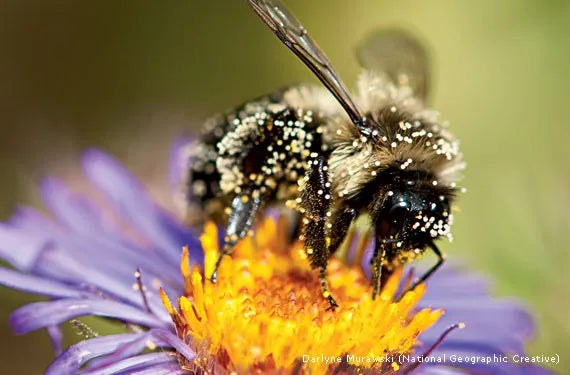Get Wild in Your Backyard
Beekeeping
Planting a wildflower garden is probably the single best way you can support local pollinators in your neck of the woods. There’s no reason to leave pollination up to local bees and their keepers – you can easily help your local ecosystem without leaving your backyard. Don’t worry: you can put down that beekeeper suit. With a little planning and a greenish thumb, you can plant a garden that supports all kinds of wild pollinators, including the many, many species of wild bees.
Bee Basics
Before we get in the weeds, let’s start with a quick overview of pollination. It’s the process of moving pollen between flowers of the same species, and it’s also the first step in plant reproduction. Whenever a bee visits a flower, she gathers two kinds of food: nectar, a sweet-smelling liquid that she drinks, and pollen, which she brings back to the hive to make into honey.
Plan Your Plants
Your garden supports pollinators in two ways: providing both food and shelter. Some wild bees nest in the soil near their favorite pollen sources, while others, like leafcutter bees, build nests out of the plants around them. A diverse, flowering garden means they get their favorite food and a short commute, all summer long.
However, pollinators tend to be a little picky. Over thousands of years, they’ve evolved alongside native plants, and as a result, have strong preferences for certain plants. At the same time, many flowers have evolved fragrant nectar and bright colors to attract certain pollinators’ attention. Stick with your region’s native plants, as they’re attuned to the local growing season, climate and soil. For details specific to your region, check out the Xerces Society’s guide.
Running Wild
Here’s a quick primer with some details for making your garden irresistible to bees, butterflies, hummingbirds, moths, beetles and the rest of nature’s plentiful pollinators.
- Make sure your garden is full of local plants that bloom throughout the spring, summer and fall. The exact seed mix will depend on your location.
- Don’t mix flowers at random. Plant flowers in large patches of just one kind. Not only does this attract more attention from pollinators, in makes it easier for flowers to pollinate successfully.
- Plant a diverse variety of flowering plants to reduce pest problems and provide a more balanced diet for pollinators.
- Be patient. It can take a long time for bees to find your garden, especially if you aren’t near a forest.
- Don’t use any chemical pesticides or herbicides, as these are designed to kill pollinators and certain pollinator-friendly plants.
- On top of that, if you buy plants from a nursery, ask if they’re pesticide-free. Many nurseries sell plants that have been exposed to pesticides at some point in their life. Your best bet is to buy seeds without pesticide coatings.
- Plant your garden in a sunny area with plenty of bare soil and ample drainage.
You can learn more about pollinators and habitat gardens from Butterfly Pavilion and PACE. And you can learn more about raw and unfiltered honey, beekeeping and recipes right here at the Local Hive Blog.

